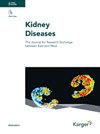Nephropathy Is Aggravated by Fatty Acids in Diabetic Kidney Disease through Tubular Epithelial Cell Necroptosis and Is Alleviated by an RIPK-1 Inhibitor
IF 3.2
4区 医学
Q1 UROLOGY & NEPHROLOGY
引用次数: 1
Abstract
Introduction: Diabetic kidney disease (DKD), one of the leading causes of end-stage renal disease, has complex pathogenic mechanisms and few effective clinical therapies. DKD progression is accompanied by the loss of renal resident cells, followed by chronic inflammation and extracellular matrix deposition. Necroptosis is a newly discovered form of regulated cell death and is a major form of intrinsic cell loss in certain diabetic complications such as cardiomyopathy, intestinal disease, and retinal neuropathy; however, its significance in DKD is largely unknown. Methods: In this study, the expression of necroptosis marker phosphorylated MLKL (p-MLKL) in renal biopsy tissues of patients with DKD was detected using immunofluorescence and semiquantified using immunohistochemistry. The effects of different disease-causing factors on necroptosis activation in human HK-2 cells were evaluated using immunofluorescence and Western blotting. db/db diabetic mice were fed a high-fat diet to establish an animal model of DKD with significant renal tubule damage. Mice were treated with the RIPK1 inhibitor RIPA-56 to evaluate its renal protective effects. mRNA transcriptome sequencing was used to explore the changes in signaling pathways after RIPA-56 treatment. Oil red O staining and electron macroscopy were used to observe lipid droplet accumulation in renal biopsy tissues and mouse kidney tissues. Results: Immunostaining of phosphorylated RIPK1/RIPK3/MLKL verified the occurrence of necroptosis in renal tubular epithelial cells of patients with DKD. The level of the necroptosis marker p-MLKL correlated positively with the severity of renal functional, pathological damages, and lipid droplet accumulation in patients with DKD. High glucose and fatty acids were the main factors causing necroptosis in human renal tubular HK-2 cells. Renal function deterioration and renal pathological injury were accelerated, and the necroptosis pathway was activated in db/db mice fed a high-fat diet. Application of RIPA-56 effectively reduced the degree of renal injury, inhibited the necroptosis pathway activation, and reduced necroinflammation and lipid droplet accumulation in the renal tissues of db/db mice fed a high-fat diet. Conclusion: The present study revealed the role of necroptosis in the progression of DKD and might provide a new therapeutic target for the treatment of DKD.糖尿病肾病中脂肪酸通过小管上皮细胞坏死加重肾病,RIPK-1抑制剂可减轻肾病
导读:糖尿病肾病(DKD)是终末期肾脏疾病的主要病因之一,其发病机制复杂,临床有效治疗方法少。DKD的进展伴随着肾常驻细胞的丧失,随后是慢性炎症和细胞外基质沉积。坏死性上睑塌陷是一种新发现的受调节细胞死亡形式,是某些糖尿病并发症(如心肌病、肠道疾病和视网膜神经病变)中固有细胞损失的主要形式;然而,它在DKD中的意义在很大程度上是未知的。方法:本研究采用免疫荧光法检测DKD患者肾活检组织中坏死下垂标志物磷酸化MLKL (p-MLKL)的表达,免疫组织化学半定量检测。采用免疫荧光法和Western blotting法观察不同致病因子对人HK-2细胞坏死坏死活化的影响。采用高脂饲料喂养db/db糖尿病小鼠,建立肾小管明显损伤的DKD动物模型。小鼠用RIPK1抑制剂RIPA-56处理,以评估其肾脏保护作用。利用mRNA转录组测序技术探讨RIPA-56处理后信号通路的变化。采用油红O染色和电子显微镜观察肾活检组织和小鼠肾组织中脂滴积聚情况。结果:磷酸化RIPK1/RIPK3/MLKL免疫染色证实DKD患者肾小管上皮细胞发生坏死下垂。坏死下垂标志物p-MLKL的水平与DKD患者肾功能、病理损害和脂滴积聚的严重程度呈正相关。高糖和脂肪酸是引起人肾小管HK-2细胞坏死的主要因素。高脂饮食会加速db/db小鼠的肾功能恶化和肾病理损伤,并激活坏死下垂途径。应用RIPA-56可有效降低高脂喂养db/db小鼠的肾损伤程度,抑制坏死下垂通路激活,减少肾组织坏死炎症和脂滴积聚。结论:本研究揭示了坏死上睑下垂在DKD进展中的作用,可能为DKD的治疗提供新的治疗靶点。
本文章由计算机程序翻译,如有差异,请以英文原文为准。
求助全文
约1分钟内获得全文
求助全文
来源期刊

Kidney Diseases
UROLOGY & NEPHROLOGY-
CiteScore
6.00
自引率
2.70%
发文量
33
审稿时长
27 weeks
期刊介绍:
''Kidney Diseases'' aims to provide a platform for Asian and Western research to further and support communication and exchange of knowledge. Review articles cover the most recent clinical and basic science relevant to the entire field of nephrological disorders, including glomerular diseases, acute and chronic kidney injury, tubulo-interstitial disease, hypertension and metabolism-related disorders, end-stage renal disease, and genetic kidney disease. Special articles are prepared by two authors, one from East and one from West, which compare genetics, epidemiology, diagnosis methods, and treatment options of a disease.
 求助内容:
求助内容: 应助结果提醒方式:
应助结果提醒方式:


